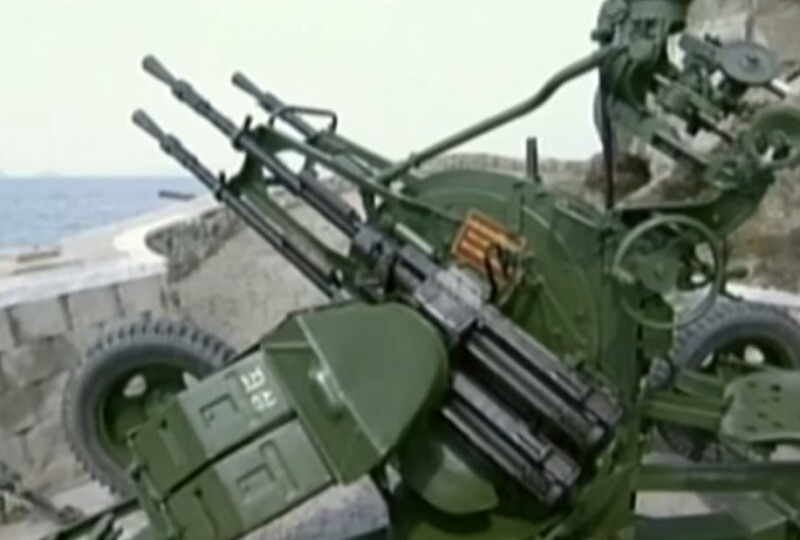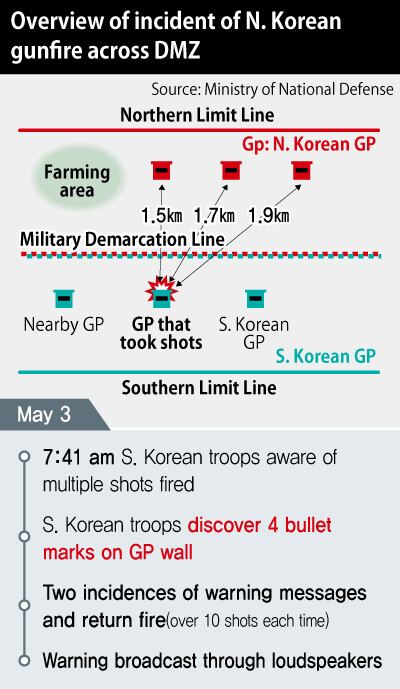hankyoreh
Links to other country sites 다른 나라 사이트 링크
JCS misreported effective range of N. Korean artillery fired at S. Korean GP

Military authorities previously cited the inability of North Korean military firearms’ effective range to cover the distance between the two sides’ guard posts as a reason for not viewing a May 3 incident of gunfire as a “deliberate provocation” -- but this conclusion has now been shown to be contrary to the facts. Critics contended that the failure to give an accurate account of the circumstances behind the misleading report have contributed to the growing controversy over whether the gunfire was accidental or deliberate.
In a press briefing shortly after the gunfire exchange on May 3, a Joint Chiefs of Staff (JCS) official suggested that the distance of 1.5–1.9 km between the North Korean guard post and the South Korean guard post that was fired upon fell outside of the effective range of the firearms used by the North Korean military in the incident.
“It’s common sense that if that North Korean military had been planning a deliberate provocation, it would have had to do so within the effective firing range,” the official said.

At the time, the official did not mention what firearm had been used by the North Korean side in the incident. But sources said the JCS indicated in a report the following day to Democratic Party lawmaker Ahn Gyu-back, who chairs the National Assembly National Defense Committee, that the firearm in question appeared to have been a 14.5mm machine gun.
The problem is that the JCS stated themselves that the effective firing range of a 14.5 mm heavy machine gun, which is used as an antiaircraft weapon by the North Korean military, is 3km. In data submitted to the National Assembly in 2018, the JCS names six types of firearms possessed by North Korean guard posts – an AK automatic rifle, a Type 73 light machine gun, an RPG-7 (a rocket-propelled grenade launcher), a catapult, a 14.5mm machine gun, and a 82mm recoilless rifle. Among these, it stated that the 14.5mm machine gun had an effective range of 3km. If the machine gun has an effective range of 3km, that would place the distance of 1.5-1.9 km between the two sides’ guard posts within the weapon’s range -- showing the JCS’ explanation at the time to have been false.
In response to the controversy, Kim Jun-rak, head of the JCS information office, explained in a May 7 briefing that the South Korean military “views the firearm in question as having a maximum range of 8km and an effective range of 1.4km.”
“We will need to look a bit more into why the assessment of a ‘3km effective firing range’ was listed in the National Assembly report,” Kim added. The remarks amounted to a feeble explanation that cast doubts on the credibility of information submitted to the National Assembly by the JCS themselves just two years ago. The general view among experts is that the machine gun’s effective range is 1.4km when it is used as an antiaircraft weapon and 3 km when it is fired toward a target on the ground.
The JCS official’s decision at the time to refer to the machine gun’s effective range when used as an antiaircraft weapon in discussing the firearm’s range appears to have been intended to emphasize that the North Korean gunfire did not represent an intentional provocation. But many are arguing that regardless of the question of intentionality, it amounted to misleading the press -- and undermining trust in the JCS’ own explanations in the process. Some observers are also voicing concerns that the approach of attempting to cover up proven falsehoods without providing logical explanations stands to increase distrust in the military in the long term.
By Noh Ji-won, staff reporter
Please direct comments or questions to [english@hani.co.kr]

Editorial・opinion
![[Column] Season 2 of special prosecutor probe may be coming to Korea soon [Column] Season 2 of special prosecutor probe may be coming to Korea soon](https://flexible.img.hani.co.kr/flexible/normal/500/300/imgdb/original/2024/0426/3317141030699447.jpg) [Column] Season 2 of special prosecutor probe may be coming to Korea soon
[Column] Season 2 of special prosecutor probe may be coming to Korea soon![[Column] Park Geun-hye déjà vu in Yoon Suk-yeol [Column] Park Geun-hye déjà vu in Yoon Suk-yeol](https://flexible.img.hani.co.kr/flexible/normal/500/300/imgdb/original/2024/0424/651713945113788.jpg) [Column] Park Geun-hye déjà vu in Yoon Suk-yeol
[Column] Park Geun-hye déjà vu in Yoon Suk-yeol- [Editorial] New weight of N. Korea’s nuclear threats makes dialogue all the more urgent
- [Guest essay] The real reason Korea’s new right wants to dub Rhee a founding father
- [Column] ‘Choson’: Is it time we start referring to N. Korea in its own terms?
- [Editorial] Japan’s rewriting of history with Korea has gone too far
- [Column] The president’s questionable capacity for dialogue
- [Column] Are chaebol firms just pizza pies for families to divvy up as they please?
- [Column] Has Korea, too, crossed the Rubicon on China?
- [Correspondent’s column] In Japan’s alliance with US, echoes of its past alliances with UK
Most viewed articles
- 1No good, very bad game for Korea puts it out of Olympics for first time since 1988
- 2[Column] Season 2 of special prosecutor probe may be coming to Korea soon
- 3Korea’s 1.3% growth in Q1 signals ‘textbook’ return to growth, says government
- 4‘We must say no’: Seoul defense chief on Korean, USFK involvement in hypothetical Taiwan crisis
- 5Is N. Korea threatening to test nukes in response to possible new US-led sanctions body?
- 6Division commander ordered troops to enter raging flood waters before Marine died, survivor says
- 7[Column] ‘Choson’: Is it time we start referring to N. Korea in its own terms?
- 8Will NewJeans end up collateral damage in internal feud at K-pop juggernaut Hybe?
- 9Korea sees more deaths than births for 52nd consecutive month in February
- 10[Editorial] Korea’s surprise Q1 growth requires objective assessment, not blind fanfare